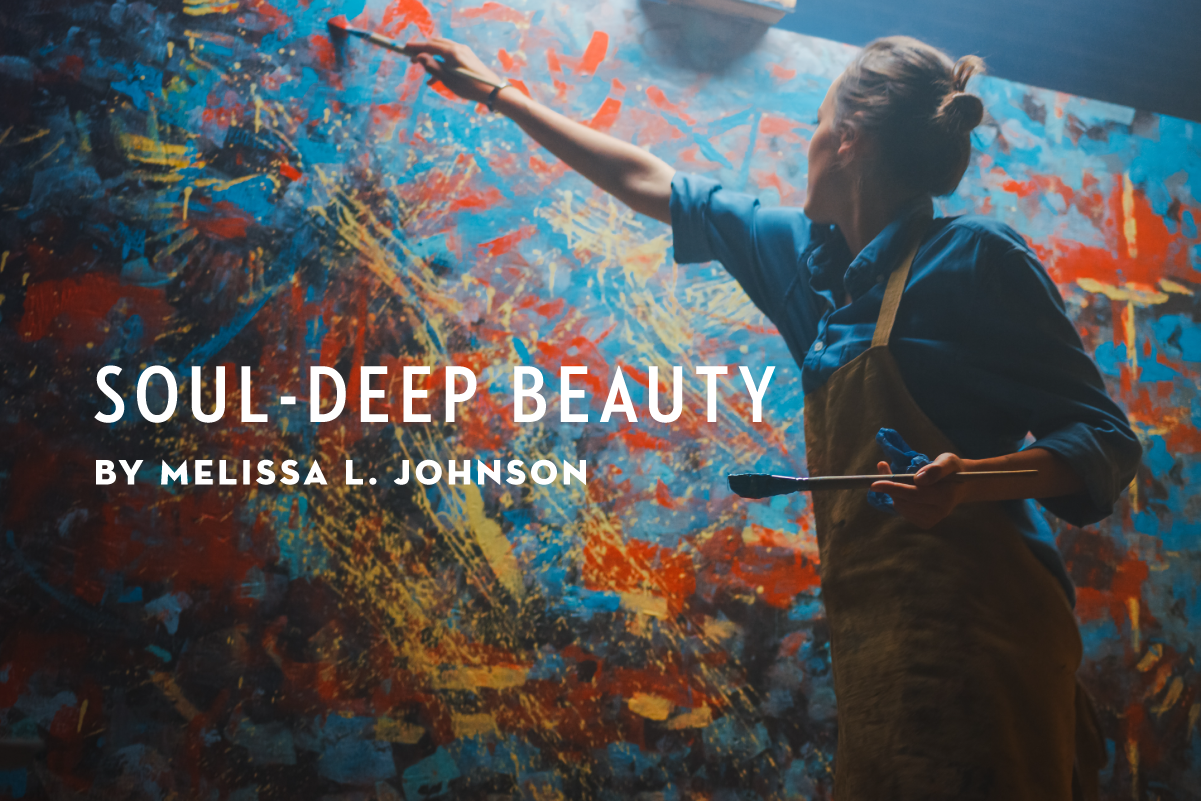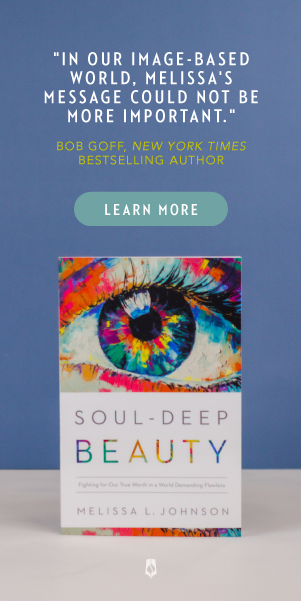
Toxic “Beauty” Is Impacting Our Souls. Here’s What We Can Do about It.
I was thirty-one years old and working as a marriage and family therapist when I was diagnosed with an eating disorder and strongly recommended to begin intensive treatment.
It felt surreal and ironic.
It was totally unexpected and felt like a slap in the face. Where did this diagnosis come from, and how had it remained camouflaged to me for so long?
Though denial likely had its place in the mix, looking back I now see why my struggle with an eating disorder was hard for me to recognize and accept. So many of the beliefs and behaviors that made up the disorder were in fact popular cultural beliefs as well.
Growing up, I had been subtly and not so subtly coached about the virtue of weight loss, of restricting or omitting certain food groups, and of the pursuit of “health” (meanwhile, “health” looked like thin, toned, and tan celebrities and fitness models who appeared on popular products or magazines).
In so many ways, the disorder remained unobvious, because I thought I was doing it “right.” I thought I was supposed to be consumed with “perfecting” my food and dedicated to a rigorous fitness routine. This was the way of “beauty” in America, the way of virtue, health, and goodness. Right?
We scroll and scroll and scroll some more. Day after day, we are being formed by the influence of media, social media, and advertisements. Ads for miracle supplements, images of influencers’ “flawless” physiques, and diet products’ before and after photos. Images of idealized “beauty” saturate our minds and hearts. But how often do we stop and wonder, How might they be impacting us?
Perhaps, like you, I once assumed that these images likely aren’t great to take in, but how bad can they be? I didn’t realize the widespread, soul-deep damage of societal beauty until it had a chokehold on my life.
Broken Beauty
Intensive eating disorder treatment forced me to put a hold on life as I knew it. It also forced me to take a deeper look at our societal definition of “beauty” and how the media, advertising, and the beauty and diet industries play their roles in its construction and fortification.
I was given eyes to see societal “beauty” in a new way; “beauty” was exposed for what it really was. Totally empty and not beautiful at all.
I saw how societal “beauty” ran on insecurity and shame. And that it was all on purpose. Making women feel like their face, or body, or skin is “wrong” so they’ll adhere to a diet or buy a product to “fix” themselves. In short, I was awakened to the black hole that is American “beauty,” its gravity impacting the minds, the hearts, the souls of so many girls and women.
It was so wrong. A great ploy of misdirection. The energies of our beautiful minds and hearts focused toward something that is fleeting and so often literally fake. A brilliant scheme by the diet and beauty industries, as well as Evil itself.
As Paul reminds us in Ephesians 6:12, “our struggle is not against flesh and blood, but against the rulers, against the authorities, against the powers of this dark world and against the spiritual forces of evil in the heavenly realms” (niv). And if there is any ploy of evil that is disintegrating and depleting women and girls en masse, society’s twisted definition of beauty is it.
Redefining Beauty
In intensive treatment, I also had an up-close view of some of the fallout of societal beauty; I observed the trajectory of what it taught, what it valued and its end. With distinct clarity, I saw that it brought no life. While Jesus invites us to fullness of life (John 10:10), I experienced how following the agenda and teachings of societal beauty depleted me of vitality and wholeness in so many ways. Disconnecting me from my body, my intuition, and from other women. I saw it do the same in the lives of so many others, both in and outside of treatment.
I saw the trajectory and agenda of broken beauty and had to abandon it.
With new eyes, I became enthralled with a truer and deeper beauty. A kind of beauty that doesn’t lead to obsession, comparison, judgment, or self-criticism.
The kind of beauty that meets the deepest longings of our soul and helps us embrace “life that is truly life” (1 Timothy 6:19 niv).
On this side of treatment, I define true beauty as “the life of God at work in us and among us.” “Beauty” is no longer reserved for the “fit” and “flawless.” Instead, it’s everywhere, because the life and love of God are at work everywhere (see 1 John 4:16). The eternal dance of the Trinity is at work in us and all around us as, and that has been since the beginning of time. I see it in the twinkling, curious eyes of my nieces and nephews. In the connection between a parent and their child, and in the vastness of the night sky.
You see, our souls are not a separate, “spiritual” part of us. Rather, our souls, the essence of who we are, are impacted by our thoughts, our emotions, our relationships, our connection with God, our bodies, our sense of purpose in the world. And when we are pursuing a kind of “beauty” that is false, not the real thing, it brings about disintegration and brokenness in so many areas of our lives. Our thought life. Our relationships. Our sense of purpose in the world. And the list goes on.
While societal beauty divides and dis-integrates us individually and collectively, true beauty brings about wholeness and thriving. It connects us to others, to ourselves, to God, and to our deeper purpose in the world. It’s that kind of beauty we have been created for.
How Can We Redefine Beauty Together?
What we believe about beauty matters. Our definition of beauty impacts so many things: our relationship with food and our bodies, our sense of identity and value, and our sense of purpose. Furthermore, our beliefs and actions related to beauty impact us, and they impact others. They will impact the next generation.
So what can we do to shift our own definition of beauty in tangible ways?
1.) Put boundaries around media and social media use: So much of media and social media exposes us to unrealistic images of societal beauty. Whatever we put into our minds and hearts is shaping us. I invite us to turn down the volume on societal “beauty” so we can turn up the volume on true beauty. And if or when you do engage social media, I recommend following accounts that feature diverse body shapes, sizes, et cetera.
2.) Change the dialogue about our bodies: Diet and beauty culture have taught us to view our faces and bodies with an eye toward criticism; what needs tweaking or “fixing”? What if, instead, we considered our embodied selves with gratitude? Perhaps considering what miracles our bodies are or what amazing things they can do and how they support us in the world.
3.) Consider food as a gift: Again, diet culture has taught us to view food restriction as positive and to label some foods as “good” and others as “bad.” What if, instead, we considered food as an amazing gift from God. Wrapped up in the diversity of foods are the unique nutrients needed to nurture our brains and bodies. What if food weren’t an occasion for fear and judgment, but celebration and gratitude?
4.) Give true beauty more airtime than societal beauty: When it comes to our brains, “what fires together, wires together,” as the saying goes, meaning the more we think a certain thought or do a certain action, the more well-worn that neuropathway in the brain becomes and the easier it will be for our brains to fire in that same way again. So the more we pick up our phones to scroll social media’s brand of influencer and photoshopped “beauty,” the more likely it is we will do that behavior again.
Thankfully, we can leverage this same neurobiology to focus on true beauty. For instance, we can focus on when and where we are experiencing the life of God in our life or in our midst. One way to do this might be to tune into the present moment with all five senses. In what ways is the life of God present to you in this moment? In your breath? In the sounds of nature’s sustaining rhythms outside your window? In the tenderness in a friend or family member’s voice as they speak to you. The life of God is at work in us and all around us. This practice helps us have eyes to see it.
To learn more about my journey, why I had to redefine beauty, and my invitation for you to do the same, please check out my book, Soul-Deep Beauty: Fighting for Our True Worth in a World Demanding Flawless (Bethany House, 2023).


